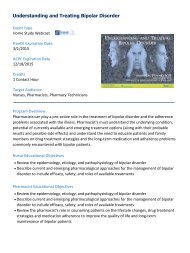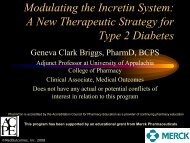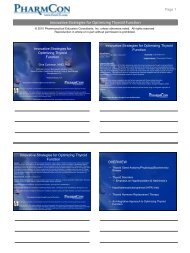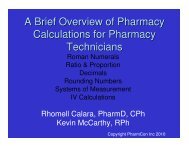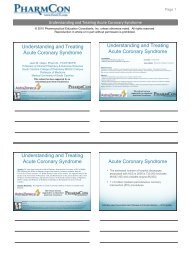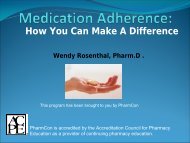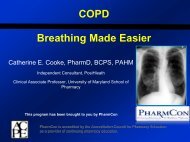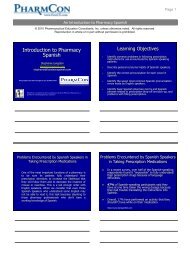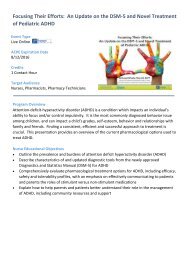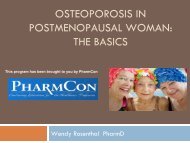AEDs - Free CE Continuing Education online pharmacy, pharmacists
AEDs - Free CE Continuing Education online pharmacy, pharmacists
AEDs - Free CE Continuing Education online pharmacy, pharmacists
- No tags were found...
You also want an ePaper? Increase the reach of your titles
YUMPU automatically turns print PDFs into web optimized ePapers that Google loves.
Understanding and ManagingEpilepsyJacquelyn L. Bainbridge, Pharm.D., FCCPAssociate ProfessorUniversity of Colorado DenverSchool of Pharmacy & Department of NeurologySupported by an educational grant from UCBPharmCon is accredited by the Accreditation Council for Pharmacy <strong>Education</strong> as a provider ofcontinuing <strong>pharmacy</strong> education
Understanding and ManagingEpilepsyAccreditation:Pharmacist: 798-000-09-033-L01-PPharmacy Techs: 798-000-09-033-L01-T<strong>CE</strong> Credits: 1.0 contact hourTarget Audience: Pharmacists & TechniciansProgram Overview:Epilepsy is a neurological disorder in which clusters of nerve cells in the brain sometimes signal abnormally. Thisdisorder affects about 2.7 million Americans, and results in an estimated annual cost of $15.5 billion in medical costsand lost or reduced earnings and production. People of all ages are affected, but particularly the very young and theelderly. For epilepsy, understanding the disorder and behaviors associated with it is imperative. The pharmacologicalapproach to this issue is specific and may require special attention. This program is designed to assist <strong>pharmacists</strong>review the facets of the condition of epilepsy, as well as the benefits of controlling episodes with medications. Theirknowledge of available options for epileptic patients will be enhanced. The program includes information onpharmacologic treatments, drug interactions, patient counseling, and a question/answer period.Objectives:•Pharmacists will state the theories associated with the causes of epilepsy, as well as detrimental affects that thisdisorder may have on its victim’s lives, incorporating information on the prevalence of this predicament.•Pharmacists will list therapeutic agents used in the treatment of epilepsy, and be able to state an agent’s dosageschedule, mechanism of action, and side effects.•Pharmacists will be able to explain the pharmacological and non-pharmacological options for patients suffering fromepilepsy, to include their mechanisms of action, efficacy, dosing, safety, and tolerability profiles.Supported by an educational grant from UCB
Understanding and ManagingEpilepsySpeaker: Jacquelyn L. Bainbridge, BSPharm, PharmD., FCCP, received her doctorate of<strong>pharmacy</strong> from the University of Colorado School of Pharmacy, where she subsequentlycompleted a specialty residency in neurology. Dr. Bainbridge currently serves as an AssociateProfessor at the University of Colorado Denver School of Pharmacy, Department of ClinicalPharmacy and Department of Neurology in the School of Medicine.Speaker Disclosure: Dr. Bainbridge has no actual or potential conflicts of interest in relationto this programSupported by an educational grant from UCB
Objectives• Describe the epidemiology and cause ofepilepsy• Compare and contrast the pharmacokineticand pharmacodynamic characteristics ofthe first and second generationantiepileptic drugs (<strong>AEDs</strong>) in the treatmentof epilepsy• Describe pharmacologic and nonpharmacologictreatment options for thetreatment of epilepsy
Outline• Overview of the disorder• Pharmacokinetic differences between first generation <strong>AEDs</strong>• First generation AED specific adverse drug reactions (ADRs)• Pharmacokinetic differences between second generation <strong>AEDs</strong>• Second generation AED specific ADRs• New <strong>AEDs</strong>• Generic substitution• Cytochrome P450 enzymes• Broad spectrum• Mechanism of action• Drugs on the horizon• Summary
Epidemiology of Epilepsy• 1/100 adults are diagnosed with epilepsy• 1/50 children are diagnosed with epilepsy• 200,000 new cases are diagnosed per year• In 70% of new cases, no cause apparent• Annual burden ~ $12.5 billion indirect anddirect healthcare costEpilepsy Foundation: www.epilepsyfoundation.org
Incidence of Epilepsy
Hauser A. Epilepsia. 1992;33(suppl 4):S6-S14.Most Common Seizure TypeComplex partial36%Partial onsetSimple partial14%Partial unknown7%Generalizedtonic-clonic23%Unclassified3%Myoclonic3%Absence6%Other generalized8%
Success in AED RegimensSeizure free 47%Monotherapy first AEDNot seizure free 36%All regimens attemptedSeizure free 13%Monotherapy 2nd AEDSeizure free 1%Monotherapy 3rd AEDSeizure free 3%PolytherapyKwan and Brodie N Engl J Med. 2000.
Treatment Options in Epilepsy• Antiepileptic Drugs (<strong>AEDs</strong>)– 1st Generation– 2nd Generation– Extended Release• Devices– Vagus Nerve Stimulation (VNS ® )– Feedback Devices in Development• Epilepsy Surgery• Ketogenic diet and Alternative TherapiesLowenstein DH. Seizures and epilepsy. Harrison’s Principles of Internal Medicine. 16th ed. New York, NY:McGraw-Hill; 2005.
Comparative Pharmacokineticsof 1st. Generation <strong>AEDs</strong>Drug F % Binding % CI t ½ (hrs)Cause PKInteraction?CBZ 80 75-85 100% H * 6-15 yesPB 100 50 75% H 72-124 yesPHT 95 90 100% H ** 12-60 yesVPA 100 75-95 ** 100% H 6-18 yes* autoinduction** non-linearProblems:Poor water solubilityExtensive protein bindingExtensive oxidative metabolismMultiple drug-drug interactions
Drug-Specific Side Effects:Old Established <strong>AEDs</strong>AEDPhenytoinCarbamazepineValproatePhenobarbitalPrimidoneDrug-Specific AEAtaxia, gingival hyperplasiaTremor, myoclonus, hyponatremia,cardiotoxicity, sexual dysfunction, visualdistortionTremor, encephalopathy, pedal edema, hairloss, weight gainConnective tissue disorders*,erectile dysfunction, sedationConnective tissue disorders*,erectile dysfunction, sedation* Dupuytren’s contractures, Ledderhose syndrome, Peyronie’s disease, frozen shoulderRamsay, Rowan & Pryor.
Gingival Hyperplasia Inducedby PhenytoinNew Eng J Med. 2000:342:325.
After Withdrawal of PhenytoinNew Eng J Med. 2000:342:325.
Stevens-Johnson Syndromehttp://missinglink.ucsf.edu/lm/DermatologyGlossary/img/Dermatology%20Glossary/Glossary%20Clinical%20Images/Stevens_Johnson-28.jpg
Bone Health• Gradual decline in bone mass and bonemineral density (BMD) with advancing age• Increased risk of osteoporosis andfractures with some <strong>AEDs</strong> by interferingwith Vitamin D metabolism• PHT, PB, CBZ and possibly VPA increaserisk for osteopenia/osteoporosis• Limited data with newer <strong>AEDs</strong>
Trabecular Bone(http://www.merck.com)
Sexual Function• Sexual dysfunction described in 30-60%of men and women with epilepsy• Older <strong>AEDs</strong> (phenytoin, carbamazepine,phenobarbital & primidone) induce hepaticdrug metabolism• CytochromeP450 isozymes participate inmetabolism of estradiol and testosterone• Increased hepatic synthesis of sex hormonebinding globulin (SHBG) → ↓concentrationsof bioactive androgen
Pharmacokinetics of Newer <strong>AEDs</strong>Drug Absorption Binding Elimination a,b (hrs)T ½CauseInteractions?GBP ≤ 60% c 0% 100% renal 5-9 NoLTG 100% 55% 100% hepatic 18-30 NoLEV ~100%
Drug-Specific Side Effects:Newer <strong>AEDs</strong>AEDGabapentinPregabalinLamotrigineDrug-specific AEMyoclonus, pedal edema, weight gainSimilar to gabapentinDose & titration-dependent rash, visualdistortionTopiramateZonisamideRenal stones, word-finding difficulties,paresthesia, weight loss, glaucoma,metabolic acidosisRenal stones, paresthesia, weight loss,metabolic acidosis
Drug-Specific Side Effects:Newer <strong>AEDs</strong> Cont’dAEDDrug-specific AETiagabineEncephalopathy,knee-bucklingLevetiracetamSedation, behavioral changesOxcarbazepine HyponatremiaVigabatrin Irreversible visual field defects (25-33%),drowsiness, fatigue, hyperactivity (children)LacosamideRufinamideDizziness, HA, nausea, diplopia, PR-intervalincrease (minimal)Shortened QT Interval, HA, somnolence
What’s New• Levetiracetam / myoclonic seizures in JME / IV can be used for myoclonic seizuresassociated w/ JME when oral is not feasible (adults 16 and above) / initialmonotherapy indication in Europe in partial seizures / in the US adjunctivetreatment of primary generalized tonic-clonic seizures• Levetiracetam injection• Bioavailability to oral the same• Starting dose 500 mg IV BID• Dilute in NS, LR, D5W in 100 ml• Administer over 15 minutes• No loading dose required• Peak concentration in 15 minutes• Compatible with Lorazepam, Diazepam, Valproate sodium
Levetiracetam IV - Advantages• Can be used acutely• May have synergy with benzodiazepines• Easy to use• Faster onset of action• Prophylaxis in neurosurgery – SAH• 2500 mg given over 5 minutes to std SE protocolseems effective and justifies further clinicalinvestigation*• No interactions with chemotherapeutic agents,transplant drugs, or antiretroviral therapy• Price generally between phenytoin and fosphenytoin*Epilepsia 2009;50(3):415-421
Levetiracetam (Keppra®) XR• Indication: Adjunctive, > 16 years of age• Effective starting dose 1000 mg/day (2 x 500 mg tablets), now available750 mg tabs• No titration required• Can adjust daily dosage in increments of 1000 mg every 2 weeks tomaximum 3000 mg/day• Tablets should not be broken, chewed, crushed• Dose missed– Do not double next dose– If only a few hours have passed, take missed dose• IR and XR bioavailability similar• IR Cmax = 1 hour and XR Cmax = 4 hours
Pharmacokinetic Model:Keppra XR Plasma Concentrationwith Various Compliance ScenariosConcentration (μg/mL)302010CompliantLate DoseMissed DoseMissed with Rescue00 20 40 60 80Time (hr)Data on file; UCB, Inc.; October 2007.
Lacosamide (Vimpat ® )• MOA:– Selective enhancement of sodium channel slow inactivation– Binds to collapsin response mediator protein 2 (CRMP-2)• FDA Approved Indication:– Adjunctive therapy in the treatment of partial-onset seizures in patient with epilepsy aged 17years and older.– Controlled substance (schedule yet to be determined)• Dosage:– Adjunct (partial seizure)• Oral: Initial dose: 50 mg ORALLY twice daily; increase weekly by 100 mg/day given in 2divided doses up to 200 to 400 mg/day• IV: Initial dose: 50 mg IV twice daily; increase weekly by 100 mg/day given in 2 divideddoses up to 200 to 400 mg/day; infuse over 30 to 60 minutes• Dosage Forms:– Tablet: 50 mg (pink), 100 mg (dark yellow), 150 mg (salmon), 200 mg (blue) film-coated tablets– IV Solution: 200 mg/20 mL single-use vial for intravenous use• Pharmacokinetics:– Not affected by food.– Renally eliminated; 300mg/day max for CrCl
Vigabatrin (Sabril®)• MOA: GABA-transaminase inhibitor• FDA Approved indications:– Adjunctive therapy for refractory complex partial seizures in adults– Infantile Spasm• Dosage:– Seizure:• Adults:Starting dose 1gm/day; maintenance dose 2-4gm/day• Children: Starting dose 40mg/kg/day in two divided doses; maintenance dose is80-100mg/kg/day– Infantile Spasm: 50-100mg/kg/day, divided twice daily• Dosage Forms:– Powder: Sabril® [CAN]: 0.5 g [not available in the U.S.]– Tablet: Sabril® [CAN]: 500 mg [not available in the U.S.]• Pharmacokinetics:– Absorption not affected by food– Renally eliminated (adjust dose for CrCl
Rufinamide (Banzel®)• MOA: Prolongation of the inactive state of sodium channels• FDA Approved Indications: Adjunctive treatment of seizures associated with Lennox-Gastautsyndrome in children 4 years and older and adults• Dosage:– Children: 10mg/kg/day, given in two divided doses; increase by 10mg/kg every other day to atarget dose of 45mg/kg/day given in two equally divided doses– Adults: 400-800mg/day given in two equally divided doses; dose should be increased by 400-800mg every other day to a target dose of 3200mg/day in two equally divided doses– Should be taken with food– Dosage adjustment not necessary for CrCl
Benefits of Generic Antiepileptic Drugs(<strong>AEDs</strong>)• Decrease cost– Patient– Third party payor• Increase availability– Multiple manufacturing sources• Potential better adherenceBased on AAN and AES consensus statement
Generic to Generic SubstitutionThe variability between generic A and generic B may be too much forMean F (% of branded product)some patients and lead to loss of seizure control or adverse events.150%125%100%75%50%25%0Mean100 %Rangeof 95-105%Mean115 %Rangeof 105-125%Mean88%Range of80-95%Brand Generic GenericAB
Treatment Considerations:What Would You Do?Complianceissues 3Type ofepilepsy 1Efficacy 1,4Patient age/comorbidities 2AEs/Toxicity 1,3,4Patient’shistory ofseizures 3Drug-druginteractions 21. Beydoun A, et al. Postgrad Med. 2002;111:69-70, 73-78, 81-82. 2. Bergey GK. Neurology. 2004;63(10 suppl 4):40-48.3. Sirven JI. Mayo Clin Proc. 2002;77:1367-1375. 4. Ferrendelli JA, et al. Epilepsy Behav. 2003;4:702-709.
AED Effects on Drug MetabolizingIsozymes• Older• Enzyme inducers (CYP1A2, 2C,3A, UGTs)– CBZ– PHT– PB/PRM• Inhibitor– VPA (CYP2C19, UGT, EH)• Newer• No effects on CYP:– LEV– LTG– ZNS– TIA– GBP– PGB– LCM• Modest inducer– OXC, TPM (CYP3A), VGB• Inhibitors– TPM, OXC (CYP2C19), VGB
Current Treatment OptionsPartialGeneralizedSimpleComplexSecondarily generalizedTonicclonicTonic Myoclonic Atonic InfantilespasmsAbsencePHT, CBZ, PB,GBP, PGB, OXC,TGB, VGBACTH,VGBESXLTGVPATPMLEVZNS(FBM)LCM
Antiepileptic Drugs: Mechanism ofActionOlder <strong>AEDs</strong>Newer <strong>AEDs</strong>Generic NameCarbamazepineSodiumChannelInhibitorXCa 2+ChannelModifierMechanism of ActionGABAAugmentingValproate ?PhenytoinPhenobarbitalGabapentinXXXGlutamateReducingLamotrigine X ?OxcarbazepineTiagabineTopiramateLevetiracetamZonisamide ? ?PregabalinXXXXSV2ATegretol ® (carbamazepine) [prescribing information]. East Hanover, NJ: Novartis; April 2008. Depakote (divalproex) delayed-release tablets [prescribing information]. AbbottPark, IL: Abbott Laboratories; October 2006. Dilantin ® (phenytoin) [prescribing information]. New York, NY: Pfizer Inc; September 2007. Neurontin ® (gabapentin) [prescribinginformation]. New York, NY: Pfizer Inc; January 2007. Lamictal ® (lamotrigine) [prescribing information]. Research Triangle Park, NC: GlaxoSmithKline; May 2007. Trileptal ®(oxcarbazepine) [prescribing information]. East Hanover, NJ: Novartis; August 2007. Gabitril ® (tiagabine) [prescribing information]. West Chester, PA: Cephalon, Inc.; February2005. Topamax ® (topiramate) [prescribing information]. Titusville, NJ: Ortho-McNeil Neurologics; April 2008. Keppra ® (levetiracetam) tablets/oral solution [prescribinginformation]. Smyrna, GA: UCB, Inc.; February 2008. Zonegran ® (zonisamide) [prescribing information]. Woodcliff Lake, NJ: Eisai Inc.; February 2007. Lyrica ® (pregabalin)[prescribing information]. New York, NY: Pfizer Inc; June 2007.X
What’s on the Horizon• Lamotrigine Extended-Release• Brivaracetam• Ganaxolone• Retigabine• Carisbamate• Many many more!!!!
Summary• Contrary to conventional wisdom, older AEDSare not completely effective in all patients• Older <strong>AEDs</strong> may be associated with adverseeffects that can impact overall effectiveness andquality of life• Newer <strong>AEDs</strong> may offer improved effectiveness• Recent FDA-approved <strong>AEDs</strong> and future <strong>AEDs</strong>may be more promising because they workdifferently versus conventional therapies
Summary• Unrecognized drug interactions may beparticipating in increased drug expense,and possibly morbidity in patients withepilepsy.• In other words, PK interactions may bemaking “cheap” <strong>AEDs</strong> a very expensivetreatment in some patients.



